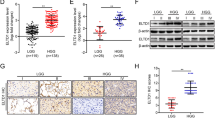Abstract
Epidermal growth factor (EGF), through interaction with specific cell surface receptors, generates a pleiotropic response that, by a poorly defined mechanism, can induce proliferation of target cells1–4. Subversion of the EGF mitogenic signal through expression of a truncated receptor5–7 may be involved in transformation by the avian erythroblastosis virus (AEV) oncogene v-erb-B, suggesting that similar EGF receptor defects may be found in human neoplasias. Overexpression of EGF receptors has been reported on the epidermoid carcinoma cell line A431 (ref. 8), in various primary brain tumours9 and in squamous carcinomas10. In A431 cells the receptor gene is amplified6,11,12. Here we show that 4 of 10 primary brain tumours of glial origin which express levels of EGF receptors that are higher than normal also have amplified EGF receptor genes. Amplified receptor genes were not detected in the other brain tumours examined. Further analysis of EGF receptor defects may show that such altered expression and amplification is a particular feature of certain human tumours.
This is a preview of subscription content, access via your institution
Access options
Subscribe to this journal
Receive 51 print issues and online access
$199.00 per year
only $3.90 per issue
Buy this article
- Purchase on Springer Link
- Instant access to full article PDF
Prices may be subject to local taxes which are calculated during checkout
Similar content being viewed by others
References
Cohen, S. J. biol. Chem. 237, 1555–1562 (1962).
Schlessinger, J. et al. Membranes in Growth and Development 359–372 (Liss, New York, 1982).
Carpenter, G. & Cohen, S. A. Rev. Biochem. 48, 193–216 (1979).
Schlessinger, J. et al. CRC crit. Rev. Biochem. 14, 93–111 (1983).
Downward, J. et al. Nature 307, 521–527 (1984).
Ullrich, A. et al. Nature 309, 418–425 (1984).
Yamamoto, et al. Cell 35, 71–78 (1983).
Fabricant, R. N., DcLarco, J. E. & Todaro, G. J. Proc. natn. Acad. Sci. U.S.A. 74, 565–569 (1977).
Libermann, T. A. et al. Cancer Res. 44, 753–760 (1984).
Cowley, G., Smith, J. A., Gusterson, B., Hendler, F. & Ozanne, B. in Cancer Cells I (eds Levine, A. J. et al.) 5–10 (Cold Spring Harbor Laboratory, New York, 1984).
Merlino, G. T. et al. Science 224, 417–419 (1984).
Lin, C. R. et al. Science 224, 843–848 (1984).
Xu, Y.-H. et al. Nature 309, 806–810 (1984).
Schimke, R. J. Cell 37, 705–715 (1984).
Mayes, E. L. V. & Waterfield, M. D. EMBO J 3, 531–537 (1984).
Weber, W., Gill, G. N. & Spiess, J. Science 224, 294–297 (1984).
Dalla-Favera, R., Wong-Staal, F. & Gallo, R. C. Nature 299, 61–63 (1982).
Kohl, N. E. et al. Cell 35, 359–367 (1983).
Schwazb, M. et al. Nature 305, 245–248 (1983).
Schwab, M. K. et al. Proc. natn. Acad. Sci. U.S.A. 81, 4940–4944 (1984).
Hayashi, K., Kakizoe, T. & Sugimura, T. Gann 74, 798–901 (1983).
Collins, S. & Groudine, M. Nature 298, 679–681 (1982).
Shimizu, N., Behzsdian, M. A. & Shimizu, Y. Proc. natn. Acad. Sci. U.S.A. 77, 3600 (1980).
Davies, R. L., Grosse, V. A., Kucherlapati, R. & Bothwell, M. Proc. natn. Acad. Sci. U.S.A. 77, 4188–4192 (1980).
Shapiro, J. R., Yung, W.-K. A. & Shapiro, W. R. Cancer Res. 41, 2349–2359 (1981).
Bartal, A. D., Heilbronn, Y. D. & Schiffer, J. Surg. Neurol. 1, 337–342 (1973).
Mark, J., Westermark, B., Ponten, J. & Hugosson, R. Hereditas 87, 243–260 (1977).
Maniatis, T., Fritsch, E. F. & Sambrook, J. Molecular Cloning (Cold Spring Harbor Laboratory, New York, 1982).
Helfman, D. M., Feramisco, J. R., Fiddes, J. C., Thomas, G. P. & Hughes, S. H. Proc. natn. Acad. Sci. U.S.A. 8, 31–35 (1983).
Maxam, A. M. & Gilbert, W. Meth. Enzym. 65, 499–560 (1980).
Taylor, J. M., Illmensee, R. & Summers, J. Biochim. biophys. Acta 4, 324–330 (1976).
Author information
Authors and Affiliations
Rights and permissions
About this article
Cite this article
Libermann, T., Nusbaum, H., Razon, N. et al. Amplification, enhanced expression and possible rearrangement of EGF receptor gene in primary human brain tumours of glial origin. Nature 313, 144–147 (1985). https://doi.org/10.1038/313144a0
Received:
Accepted:
Issue Date:
DOI: https://doi.org/10.1038/313144a0
This article is cited by
-
Signaling pathways in brain tumors and therapeutic interventions
Signal Transduction and Targeted Therapy (2023)
-
Sitravatinib is a potential EGFR inhibitor and induce a new death phenotype in Glioblastoma
Investigational New Drugs (2023)
-
Glioma targeted therapy: insight into future of molecular approaches
Molecular Cancer (2022)
-
HECTD3 regulates the tumourigenesis of glioblastoma by polyubiquitinating PARP1 and activating EGFR signalling pathway
British Journal of Cancer (2022)
-
CBX3 accelerates the malignant progression of glioblastoma multiforme by stabilizing EGFR expression
Oncogene (2022)
Comments
By submitting a comment you agree to abide by our Terms and Community Guidelines. If you find something abusive or that does not comply with our terms or guidelines please flag it as inappropriate.



